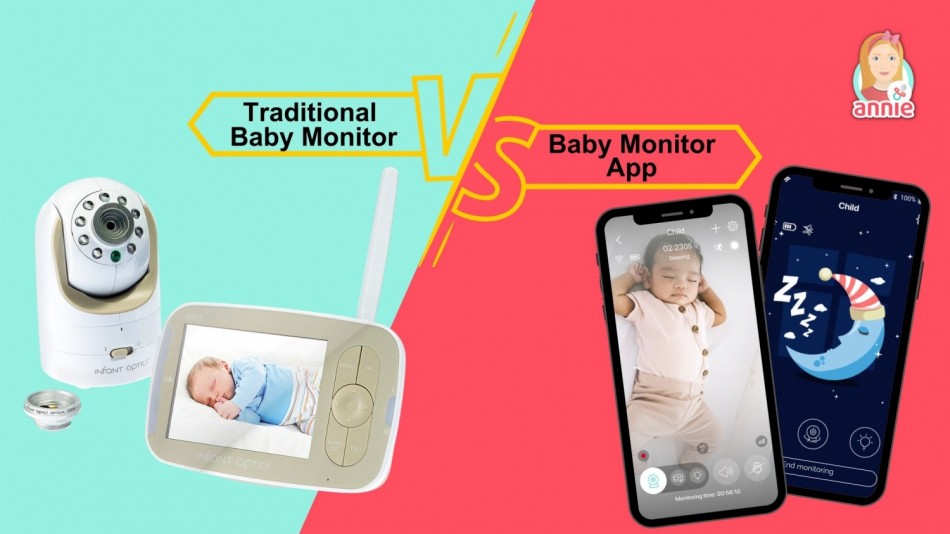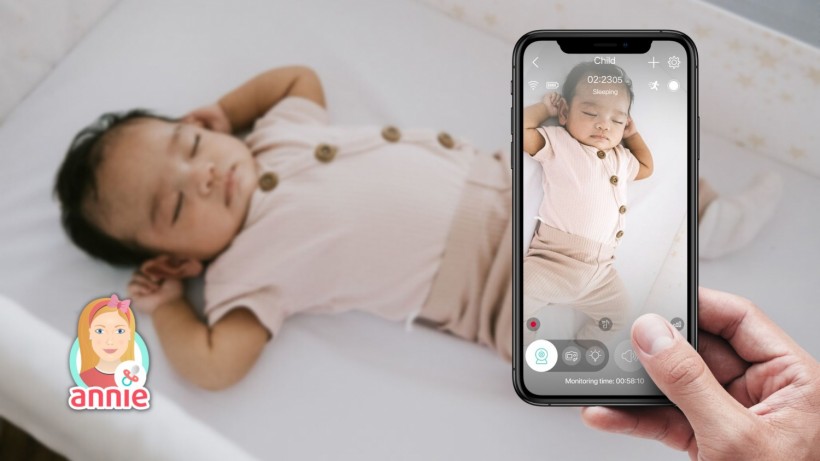Baby Monitor App vs. Traditional Baby Monitors: Which is Best for You?

As a new parent, keeping a watchful eye on your baby's safety and well-being is of the highest importance. This is where baby monitors come in. Allowing you to monitor your little one even when you're not in the same room.
However, with so many different types of baby monitors available in the market today, it can be challenging to decide which one is right for you and your family.
In this article, we will explore the pros and cons of using a baby monitor app versus traditional baby monitors. Helping you make an informed decision on which type of monitor is the best fit for your family's needs.
A Guide to Baby Monitors and Their Differences
A baby monitor is an indispensable helper that allows parents to monitor their baby's safety and well-being when they're not in the same room.
It typically consists of two parts: a transmitter and a receiver. The transmitter is placed near the baby, while the receiver is kept with the parent. The transmitter picks up sounds and movements made by the baby and sends them to the receiver, allowing the parent to hear or see their baby from a distance.
There are two main types of baby monitors available in the market: baby monitor apps and traditional baby monitors.
Baby monitor apps are software applications that use a device's camera and microphone to monitor a baby's activity and send alerts to the parent's device. They offer additional features like temperature and humidity monitoring, sleep tracking, and lullabies, are portable, and offer remote access. However, baby monitor apps rely on an internet connection and may be prone to technical issues or privacy concerns.
Hardware baby monitors are standalone devices that include a baby unit and a parent unit. The baby unit transmits sounds (and sometimes video) to the parent unit, which has a screen and speaker to receive them. Traditional baby monitors offer reliable monitoring without relying on an internet connection but are less portable and offer limited functionality beyond sound and video monitoring.
However, the type of baby monitor that is best for you may depend on your personal preferences, lifestyle, and home setup.
In the following sections, we will discuss the pros and cons of using a baby monitor app versus traditional baby monitors to help you make an informed decision.
Comparison: Baby Monitor Apps vs. Traditional Baby Monitors
When deciding between a baby monitor app and a traditional baby monitor, it's important to consider the pros and cons of each option, as well as individual preferences and needs.
The following side-by-side comparison shows the pros and cons of each option:
Baby Monitor Apps |
Traditional Baby Monitors |
Portability |
|
|
Has unlimited reach, and can be accessed from anywhere with an internet connection. |
Has limited portability, generally only usable within a certain range. |
Multi-functionality |
|
|
May offers additional features beyond sound and video monitoring, such as temperature and humidity monitoring, motion detection, etc. |
Has limited functionality and only offers sound and video monitoring. |
Price |
|
|
Is cost-effective, can be less expensive or even free since it is installed on a device parents already own |
Can be expensive, with some models costing hundreds of dollars. |
Access |
|
|
Has remote access. Can be accessed from anywhere with an internet connection. |
Has no remote access. Generally only usable within a certain range - a maximum distance of 1,000 feet. |
Reliability |
|
|
May be prone to technical issues and privacy concerns. |
More reliable since they don't rely on an internet connection to function. However, the broadcast signal may be interfered with. |
Power and internet outages |
|
|
May not function properly in the event of a power or internet outage. |
Can still function in the event of a power or internet outage if the baby monitor is battery-operated. |
It's important to consider individual preferences and needs when deciding between a baby monitor app and a traditional one.
For example, those who travel frequently or have a large home may prefer the portability and remote access offered by a baby monitor app, while those who value simplicity and reliability may prefer a traditional baby monitor.
Other factors to consider may include the type of living situation, budget, and personal preferences.
By weighing the pros and cons of each option and considering individual needs and preferences, parents can make an informed decision that works best for them and their families.
Ultimately, the decision between a baby monitor app and a traditional baby monitor depends on a number of factors. But we can suggest a universal solution. If you choose a baby monitor app, you will get much more than if you choose a classic baby monitor.
Let's take a look at the pros and cons of a baby monitor app and make sure it is the more convenient choice.
A Critical Look at Baby Monitor Apps: Pros and Cons
Baby monitor apps are a newer alternative to traditional baby monitors. Which typically require a separate device to receive the transmitted signals.
Baby monitor apps can be downloaded onto a smartphone or tablet, and the device then serves as the receiver.
Pros of Using Baby Monitor App
-
Portability - since the app is installed on your smartphone or tablet, you can take it with you anywhere you go.
-
Ease of use - most baby monitor apps are designed to be user-friendly and easily set up.
-
Accessibility - with a baby monitor app, you can access the monitor from anywhere with an internet connection. Which means you can check on your baby even when you're not at home.
-
Cost-effectiveness - many baby monitor apps are available for free or at a much lower cost than traditional baby monitors, which can be quite expensive. In addition, since the app is installed on a device that parents already own, there is no need to purchase an additional device.
-
Multi-functionality - baby monitor apps often offer additional features that traditional baby monitors don't have. For example, some apps allow parents to monitor their baby's movements, room temperature, and humidity levels in addition to transmitting sound and video.
Cons of Using Baby Monitor App
-
Technical difficulties - baby monitor apps may be prone to technical issues, such as connectivity problems, glitches, or software updates.
-
Power and internet outages - if there is a power and/or internet outage, the device that the baby monitor app is installed on may not work properly, which means the app won't be able to transmit signals.
-
Device compatibility - some baby monitor apps may only work on certain devices or operating systems, which can be frustrating for parents who have older devices or who prefer to use a different type of device.
A Summary of Baby Monitor App Benefits and Drawbacks
Here's a summarization of the pros and cons of baby monitor apps to help you make an informed decision:
|
Pros |
Cons |
|
Portability |
Technical difficulties |
|
Ease of use |
Power and internet outages |
|
Accessibility |
Device compatibility |
|
Cost-effective |
|
|
Multi-functionality |
Our Top Pick: Annie Baby Monitor App
The Annie Baby Monitor app is a popular baby monitor app that parents can use to monitor their babies using their smartphones, tablets, or computers.
The app uses the device's camera and microphone to monitor the baby's activity and sends alerts to the parent's device if there is any noise or movement. Some additional features of the Annie Baby Monitor include motion detection, VOX, sleep tracking, lullabies, and a white noise player.

Beyond Video & Audio: The Game-Changing Features of the Annie Baby Monitor App
One of the advantages of the Annie Baby Monitor app is that it is easy to use and set up. Parents can quickly download the app and connect it to their devices without needing any technical expertise.
As well as the app provides a clear and high-quality live stream of the baby's room, which allows parents to monitor their baby in real time.
Another advantage of the Annie Baby monitor app is that it is portable and convenient. Parents can use the app to monitor their baby from anywhere with an internet connection, which can be helpful for parents who travel frequently or work outside the home.
You don't have to worry about missing anything. If the baby moves or makes the slightest sound, the app will immediately warn you with a notification - your phone will give you a strong alert.
Furthermore, the app provides remote access, which allows parents to monitor their baby's sleep and activity without having to be in the same room.
The Affordable Baby Monitoring Solution
In terms of price, the Annie Baby Monitor app is available for download on the App Store and Google Play and is free to try for three days.
After the trial period, you choose and pay for your subscription based on your preferences. You can choose from weekly, monthly, or annual subscriptions.
How Annie Baby Monitor App Keeps an Eye on Your Little One
To use the Annie Baby monitor app, parents need to download and install the app on their device and their baby's device. Once the app is installed, parents can connect the two devices using Wi-Fi.
Parents can customize the app settings to receive alerts when their baby makes noise or moves, and they can also adjust the camera angle and zoom in or out as needed.
Conclusion
In conclusion, both baby monitor apps and traditional baby monitors have their pros and cons. When choosing between a baby monitor app and a traditional baby monitor, it's important to consider your living situation, budget, and personal preferences.
Ultimately, the decision between a baby monitor app and a traditional baby monitor depends on a number of factors. But we can suggest a universal solution. The Annie Baby Monitor app offers many advantages such as a low price point, reliable and clear monitoring, as well as additional features like lullabies.
© 2024 ParentHerald.com All rights reserved. Do not reproduce without permission.
* This is a contributed article and this content does not necessarily represent the views of parentherald.com
